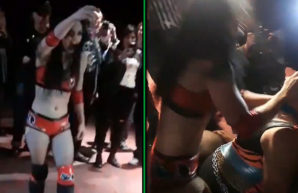In the last few weeks, TNA achieved what has eluded them for some time, and became the most talked about thing in wrestling — for being creative this time and not ridiculous. To wrap up the latest chapter in their long on-and-off feud, the Hardys held the “Final Deletion” grudge match in Matt’s backyard where the Iconic One eliminated “Brother Nero” in grand, stylized fashion. There were literal fireworks between the two, which many hailed as the freshest, most exciting thing on IMPACT, maybe ever.
Fast forward a week later to WWE RAW, and the Wyatts brawled with the New Day in a similar manner on the former’s vaunted compound. They fought in a taped segment to a standstill amid swampy conditions — Bray’s family of a seemingly dense population and his fireflies scaring off the Power of Positivity.
Final Deletion and (what is being called) The Wyatt Compound Brawl were a lot alike. Both boasted a surreal cinematic structure with tenebrous lighting, multiple angles, avant-garde editing, and minimalist production values out of the found-footage school of filmmaking. They were so similar, and airing within a week of each other, accusations of imitation arose on social media from Matt Hardy directed at Bray Wyatt.
There is evidence TNA is being imitated by WWE. The timing of the Brawl is suspect, and while the Wyatts have always been weird, something about it felt unconventional by even their standards. It is as if they were inspired by a growing trend.
TNA is, and has been, a big part that trend. The company always strove to make their backstage segments unique, looking as they do, like they were shot on 16 or 35 mm. But essential elements in the structure of Final Deletion (be it aerial photography, multiple cameras, or surrealist manipulation of the scenario) aren’t all that common. Moreover, attempts at distinction never did much for the brand aside from a bold way to cut promos or film silly skits — such as that time Shark Boy came back to life as Stone Cold Steve Austin.
No, the trend in question is much larger and more recent, something overlooked in the current discussion. That thing is Lucha Underground!
Their format, which is much closer to a movie or a TV drama, thanks in no small part to its producers (Machete director Robert Rodriguez and reality-contest impresario Mark Burnett), set the wrestling world on fire from the start. And they have been redefining the form — to some purists’ dismay — for about two years.
What’s key for bringing that about is the film-and-TV elements at play in the product. Events and exchanges outside the ring between members of the roster are presented in a style more reminiscent of a short film (with eyelines, varying angles of POV, and cuts) than old school wrestling.
Likewise, Lucha Underground is booked with serialized television in mind, more so than WWE & TNA. LU doesn’t have pay-per-views; all they’ve got is the weekly show, and it’s taped. Between vision and format, creative considerations are atypical.
And now, what started as a newfangled approach to TV by a wrestling program is becoming its own style of wrestling. It wouldn’t be a shock if “Final Deletion” pre-tape brawls stayed a regular gimmick match from here on out. The one caveat, though, could be credit for its origin remaining Underground.




